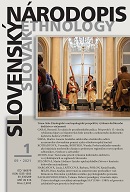Geneze ženského sukňového a košilového oděvu na moravsko-slovenském pomezí a jeho středoevropský kontext
The Origins of Women’s Skirt and Shirt Clothing on the Moravian-Slovak Border and Its Central European Context
Author(s): Martin ŠimsaSubject(s): Gender Studies, Museology & Heritage Studies, Customs / Folklore, Cultural Anthropology / Ethnology
Published by: Ústav etnológie a sociálnej antropológie Slovenskej akadémie vied
Keywords: historical clothing; undergarment; skirts with a bodice; female shirt; robe; sleeves;
Summary/Abstract: Over the past one hundred years, folk clothing has been considered one of the most significant elements of cultural heritage and has been perceived in this way not only by experts but, for many decades, by its wearers as well. In the present study, the author seeks to find an answer, based on an analysis of older expert texts, as to what formed the theoretical basis for this process, who were its representatives, at what conclusions they arrived, and how the methods of their work were reflected in the formulation of their conclusions. From the historical perspective, the study summarises the opinions on folk clothing, projected through the idea of Slavic unity, as can be observed in the case of Jan Koula and, through the reception of these opinions, also in the case of Lubor Niederle, Drahomíra Stránská and Viera Nosáľová. This work also offers newer reflections from the studies by Alena Jeřábková on the shaping of folk clothing within the Carpathian culture. Through the example of women’s linen skirts, the material part of the study seeks to point out the pitfalls of these approaches and highlight the need to study the construction of folk clothing from a longer historical perspective. Only in this way is the effect of clothing styles in the form of domestication of the individual pieces of stylish clothing evident, combined with older clothing layers. Even though most parts of folk clothing are not proto-Slavic and do not necessarily relate to the culture of the Carpathian curve, as a whole, they prove well the way the countryside managed to accept the transformations of contemporary fashion over the last four centuries and to incorporate them into a unique clothing complex.
Journal: Slovenský národopis
- Issue Year: 69/2021
- Issue No: 1
- Page Range: 30-60
- Page Count: 31
- Language: Czech

